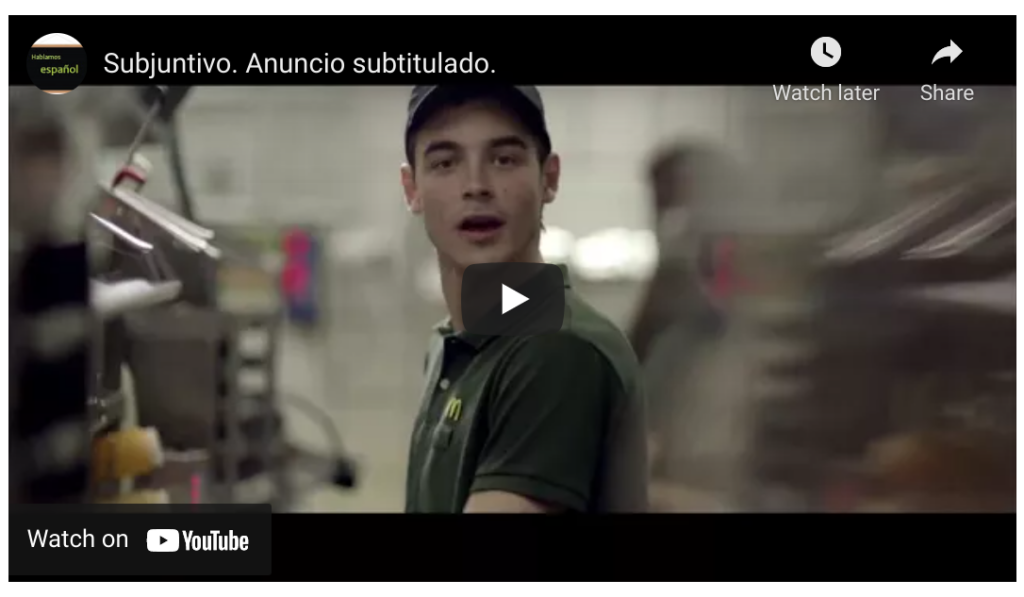Spanish Subjunctive for Beginners
Spanish grammar can often strike fear into the hearts of English-speaking language learners, especially when the topic is the Spanish subjunctive for beginners.
I get it. There are seemingly endless variations of impossible grammatical structures to memorize when hard-to-parse nuanced applications instruct you to "say it this way" unless it just so happens that you're wondering about what the other person had for lunch while you're standing on your left foot and the new moon is rising. Yikes!
The good news is that it's actually very learnable. We'll simplify it enough for you to get started with just a few hints. Then, with a little practice, you’ll even have fun using it while you speak Spanish!
In this post, we cover:
- Spanish subjunctive basics
- when to use the subjunctive in Spanish
- why to use the subjunctive in Spanish
- how do you know when to use the subjunctive in Spanish
You don’t need extra Spanish lessons to get this!
How Do You Explain the Subjunctive in Spanish?
Contrary to what most people believe, the Spanish subjunctive is not a verbal tense, but rather one of the three Spanish moods that describe an emotional or hypothetical perception of things that are not always real or fact based.
While the indicative mood expresses reality as it is and the imperative form covers commands, the subjunctive is used to communicate advice, needs, desires, opinions, doubts, feelings, possibilities, hypothesis, and so on.
Let’s illustrate this with three examples.
Let’s say we want to convey the idea of a boy playing in the park. How do we translate it in each of the three moods?
1) Indicative
El niño juega en el parque. = The boy plays in the park.
2) Imperative
¡Niño! ¡Juega en el parque! = Hey, boy! Play in the park!
3) Subjunctive
Quiero que el niño juegue en el parque. = I want the boy to play in the park.
See the difference?
And How Do You Know When to Use the Subjunctive in Spanish?
In order to appear, the subjunctive mood requires a special “trigger,” usually a verb, conjunction, or adverb that can express hope, an idea, a wish, a possibility, and so on.
But How Do You Introduce the Subjunctive in Spanish with a Trigger?
Just think about it: if you’re about to wish, hypothesize, or think about something, you need to connect your wish clause to the clause of the object you wish for.
You’ll conclude that the subjunctive mood is a subordinate clause that's connected to the main clause with “that” in English, or “que” in Spanish.
To put it simply, you’ll know it’s time to use the subjunctive mood when you’re about to tap into any feeling, wish, or opinion. Therefore, the verb requires a “that”, such as creer que (to believe that), desear que (desire that), esperar que (to hope that), gustar que (to like that), necesitar que (to need that), querer que (to want that), sentir que (to feel, regret, be sorry that), and so on.
What is an example of a subjunctive verb?
Simple sentences would look like these:
- Quiero que compres manzanas. = I want you to buy apples.
- Me alegra de que todo haya salido bien. = I’m glad that everything went well.
- Dile a Marco que juegue con su hermano. = Ask Marco to play with his brother (literally: tell).
- Espero que él se vaya pronto. = I hope that he leaves soon.
- Yo quiero que me ames. = I want you to love me.
But impersonal expressions, such as es cierto que (it’s true that), es imposible que (it’s impossible that), es raro que (it’s weird that), es obvio que (it’s obvious that), es probable que (it’s probable that), es claro que (it’s clear that), es preferable que (it’s preferable that), es fácil que (it’s easy that), and so on are the most common sentence types that use subjunctive expressions in one way or another.
- Es bueno que hayas llegado. = It’s good that you’re back.
- Es posible que ella sepa la verdad. = It’s possible that she knows the truth.
- Es necesario que me escuches. = It’s necessary that you listen to me.
- Es preciso que te vayas. = It’s important that you leave.
- Es mejor que nos vayamos. = It's better that we leave.
- Es increíble que le hayas ido a la playa. = It's incredible that you’ve been to the beach.
Also, there are special conjunctions that express a hypothetical scenario:
Comeremos pizza a menos de que traigas otra cosa. = We’ll eat pizza unless you bring something else.
Antes de que te vayas, limpia la cocina. = Before you leave, clean the kitchen.
No iré a la fiesta, aunque me lo ruegues. = I won’t go to the party, even if you beg.
Careful: conjunctions allow both indicative mood and subjunctive mood, but it all comes down to how realistic they are. Just compare:
Aunque gano mucho dinero, no puedo viajar. = Although I earn a lot of money, I can’t travel.
Aunque ganara mucho dinero, no puedo a viajar. = Even if I earned a lot of money, I can’t travel.
As you can imagine from the above example, the subjunctive mood tends to appear in sentences with two verbs. It falls usually into the subordinate clause, the first verb being a main clause in the indicative mood and the second verb in the subjunctive form, although it’s possible to find it in simple sentences that express when something “might” or will “hopefully” happen.
- Ojalá que sea mejor. = I hope it’s better.
- Puede que llueva. = It might rain.
- No creo que sepa. = I don’t think (he) knows.
- Te llamaré cuando vuelva. = I’ll call you when I’m back.
So far so good? Then it’s time to get down to the subjunctive conjugation.

The Subjunctive Forms in Spanish
A subjunctive verb can turn into several tenses and forms, and although we’d love to list each and every subjunctive conjugation in existence, we’ll discuss the most common ones that you need to remember in order to learn Spanish faster and effectively.
Present Subjunctive
As the name implies, the present subjunctive form expresses wishes, ideas, possibilities and so on in the present time. And if you’ve already mastered the present indicative conjugation, then good news: the present subjunctive endings are easy to memorize!
To create the present subjunctive endings, the only thing you have to do is to change the -ar verbs to “e” and the -er and -ir verbs to “a”!
Here are some sentences using regular verbs as examples (although irregular verbs follow a similar format):
- Puede que ella hable en la conferencia. = It’s possible that she might speak at the conference.
- Más vale que el bebé coma papillas únicamente. = You’d better feed the baby with liquid baby food only.
- A mi mamá le alegra que yo viva cerca de ella. = Mom is glad that I live nearby.
Past Simple (Imperfect)
The subjunctive past simple, or imperfect, expresses the same wishes, hopes, and possibilities, but in the past.
There are two forms for this one, but the most common one is the -ara ending, which is the one we recommend for certain verbs, if not most of them:
- Me gustaría que tú hablaras/hablases en la conferencia. = I’d like you to speak at the conference.
- Me alegra que el bebé comiera/comiese papilla. = I’m glad the baby ate liquid baby food.
- Si yo viviera/viviese junto a mamá, ella estaría contenta. = If I lived next to mom, she’d be happy.
Present Perfect
The present perfect subjunctive talks about a completed action whose effects are still palpable in present time. It’s like the present subjunctive, except that, for the former, the subjunctive clause follows this formula: the present tense of “haber” plus a participle:
- Es bueno que hayas hablado en la conferencia. = It’s good that you’ve spoken at the conference.
- Me alegra que el bebé haya comido papilla. = I’m glad the baby has eaten liquid baby food.
- Mi mamá se alegra de que yo haya vivido cerca de ella. = My mom is glad that I’ve lived nearby.
Pluperfect
The pluperfect’s verb tenses are similar to that of the present perfect’s, but instead of haya, you use hubiera.
The pluperfect subjunctive has the most uses, as it focuses on possibilities and things that, ultimately, never happened.
Essentially, you can use it in three instances:
First, to express an opinion about a past action that happened before another one.
- Fue muy triste que no hubiera llegado. = It was a shame that (he/she/it) hadn’t arrived.
- Es una suerte que no hubiera muerto. = He was so lucky that (he/she/it) hadn’t died (literally: It’s such luck that he hadn’t died).
Second, we use the pluperfect with words such as “ojalá” to hope, mourn or wish that something had happened differently in the past.
- Ojalá no hubiera pasado. = I wish it hadn’t happened.
- Ojalá hubiera llegado a tiempo. = I wish (I) had arrived on time.
Finally, the pluperfect is used quite commonly for conditional sentences about things that, once again, you wish you would have done differently in the past.
- Si hubiera estudiado, habría pasado el examen. = If I had studied, I would have passed the exam.
- Si te hubiera buscado, ¿te habrías casado conmigo? = If I had looked for you, would you have married me?
Spanish Subjunctive Practice
You’ll find the subjunctives scattered throughout Spanish-speaking media. Having problems finding examples? Don't worry, we've got you covered!
Commercial A - Presente de subjuntivo: Quiero Que

Once you get started in Spanish, you'll see a rather peculiar tendency among Spanish speakers: talking a lot with "que"! The commercial above is an example of how a seemingly unfinished "que" sentence can convey a fuller and more organic idea than a complete sentence.
In Spanish, a "que" + subjunctive usually expresses a command born from a wish, and so "quiero" (I want) is appropriate. You'll hear many Spanish speakers command a wish or desire this way.
One easier way to remember this is to think of this form as a way you'd ask a genie for a wish. Just like the female narrator was asking for a wish for everything to stop so that she could get to El Corte Inglés on time, you can use this form to express a desire to whatever "genie" you so choose.
This form will be especially useful when you wish for the traffic jam to let you pass through!
Commercial B - What is the focus: Hacer Que

This is a more complex commercial. Sentences are longer, but if you felt that the previous ad was way too simple, then this one will surely test your C2 Spanish skills!
This commercial includes another of the most commonly used subjunctive phrases: "hacer que" (to make that) + subjunctive, but in the sense that something was done in the past.
The subjunctive mood is quite sneaky here: you won't detect it right away until you understand that the ad narrator is explaining what McDonald's did before other restaurants, and whose results can be appreciated in present times. So essentially, what you have to do here is to find all instances in which it is implied that McDonald's did something followed by a specific consequence. That is, "hacer que" + subjunctive.
Three examples:
- Pero hemos conseguido que la gente se divierta comiéndola. = But we've made people have fun while eating it.
Did you expect this one? We won't blame you if you didn't: "se divierta" is a reflexive verb, and since reflexive subjunctive forms are unlike regular verbs, this one was trickier to catch!
Once again, it's implied that McDonald's did something resulting in a clear consequence: they made it possible for people to enjoy something while eating it!
- Nosotros hicimos que las nuestras fueran mágicas. = We made ours magical.
An imperfect subjunctive example. Notice how it talks about how something that McDonald's did in the past results in palpable consequences today!
- Sentarse en una (mesa) en la que sí quepamos todos, sí lo fue. = To sit down (in a table) where we all fit, it was (our idea).
Super sneaky! Notice how the subjunctive here is part of the "sentarse" clause, which connects to the idea of doing something expressed in the past. Here, the subjunctive is used as a subordinate clause, which is also possible, if not recommended, for longer sentences where the main verb is three verbs behind! (And yes, that's possible in Spanish!).
Commercial C - What is the focus: Cuándo

If the previous videos were a little bit too complex for you, this one will help you understand the subjunctive in the most elementary way!
Essentially, you can use "cuándo" (when) found in conditional sentences, not unlike "if". If you review the video, you'll eventually notice this pattern: "cuándo" + subjunctive verb + imperative verb. That's because, in Spanish, when you want to command somebody to perform an action once a condition is met, you have to use a subjunctive.
Cuando trabajes, trabaja. = When you work, work.
Cuando descanses, descansa. = When you rest, take a rest.
Cuando bailes, baila. = When you dance, dance.
It's guaranteed that, once you master these kinds of sentences, the rest of the subjunctive sentences will be easy!
If you can form a subjunctive conjugation after this, then congratulations! You’ve officially mastered the Spanish subjunctive!
Conclusion - Practice Makes Perfect
The best way to train your ear is to hear listen to speakers. Register for free to watch our Video Lessons where we've highlighted examples of the Spanish Subjunctive. We explain how and why the native speaker uses each subjunctive structure.
Do you get it? Write your best subjunctive phrase in the comments below to show us how you feel. Give it a go!





